#lilith grimoire
Explore tagged Tumblr posts
Text

The Owl House 🦉✨
my full piece for @tohgrimoire!
#the owl house#toh#luz#luz noceda#too king#king#toh eda#eda#eda clawthorne#toh lilith#lilith#lilith clawthorne#toh hooty#hooty#pixel art#my art#my pixel art#artists on tumblr#so happy I'm finally able to share this full piece!#the TOH Grimoire zine is so so stunning
8K notes
·
View notes
Text
This is common knowledge for anyone on the r/demonolatrypractices subreddit but I realized that a lot of you aren’t on there and are missing out on some great resources, so if you’re looking for reading material on demonology and demonolatry definitely check out the website below.
These basic resources come straight from Demonology the subreddit. I did not compile any of this, I’m just sharing for the folks on Tumblr. (Honestly even if you aren’t fond of that sub you should definitely take advantage of their deep dives by experienced practitioners, it really is a great resource):
Some book recommendations
Essential Background:
*On the Hieratic Art* by Proclus
*The Testament of Solomon*
*The Picatrix*
*Three Books of Occult Philosophy* by Agrippa
*The Fourth Book of Occult Philosophy* by Pseudo-Agrippa
Classic Grimoires:
*The Sworn Book of Honorius (Liber Juratus)*
*The Book of the Sacred Magic of Abramelin the Mage*
*The Heptameron* by Pietro d'Abano
*The Greater Key of Solomon*
*The Lesser Key of Solomon (Lemegeton)*
*Grimorium Verum*
For Spiritual/Theological Grounding:
*Timaeus* by Plato
*Parmenides* by Plato
*Chaldean Oracles*
*The Corpus Hermeticum*
*On the Mysteries (De Mysteriis)* by Iamblichus
*Psychic Self-Defense* by Dion Fortune
*Initiation Into Hermetics* by Franz Bardon
Good Contemporary Books:
*Secrets of the Magickal Grimoires* by Aaron Leitch
*Pandemonium* by Jake Stratton-Kent
*Stellas Daemonum* by David Crowhurst
About Lilith:
The Mighty Book List:
Introductory guides (the books that have their own systems of working with spirits included in them, therefore you can try working with spirits if you have any one of these books):
"The Complete Book of Demonolatry" by S. Connolly, (I consider this to be essential)
"Lucifer and The Hidden Demons: A Practical Grimoire from The Order of Unveiled Faces" by Theodore Rose,
"Demons of Magick: Three Practical Rituals for Working with The 72 Demons" by Gordon Winterfield
"Consorting with Spirits: Your Guide to Working with Invisible Allies" by Jason Miller.
Each one of these books will have wildly different approaches. Try them, see what works for you and what doesn't.
Classic grimoires (these are good to read through to see the working with demons through a historical lens. Some people still use methods in these books, most new books will at the very least borrow elements, such as names, sigils and correspondences):
"The Book of the Sacred Magic of Abramelin the Mage" (Dehn ed. is recommended)
"The Greater Key of Solomon",
"The Lesser Key of Solomon" aka Lemegeton (Peterson ed. is best, Mathers/Crowley is its own thing worth reading but incomplete),
"Pseudomonarchia Daemonum" (repeats a lot of information that Lesser Key has, but is older, so worth a read if you're into history of occult),
"Grimorium Verum" (Peterson ed. or JSK's "True Grimoire"),
"The Grand Grimoire" (aka Red Dragon)
"The Grimoire of St. Cyprian",
" The Goetia of Dr. Rudd".
Books that are good to read for general occult/ magick background:
"The Egyptian Book of the Dead",
"Chaldean Oracles",
"On the Mysteries" by Iamblichus,
"The Greek Magical Papyri",
"The Testament of Solomon",
"The Picatrix",
"Three Books of Occult Philosophy" by Agrippa,
"The Fourth Book of Occult Philosophy" by Pseudo-Agrippa,
"Transcendental Magic" by Eliphas Levi,
"Psychic Self-Defense" by Dion Fortune,
"Initiation into Hermetics" by Franz Bardon,
"The Golden Dawn" by Regardie/Greer,
"Chicken Qabalah" by Lon Milo Duquette,
"Liber Null and Psychonaut" by Peter J. Carroll.
Contemporary reference books (dictionaries, history books on a spirit and other similar compilations):
"The Dictionary of Demons: Expanded and Revised: Names of the Damned" by Michelle Belanger,
"Book of the Fallen: Satanic Theory, Ethics, and Practice" by Martin McGreggor,
"Lucifer: Princeps" by Peter Grey,
"Rites of Lucifer" by Asenath Mason,
"The Goetia Devils" by Rev. Cain,
"Secrets of the Magickal Grimoires: The Classical Texts of Magick Deciphered" by Aaron Leitch,
"Pandemonium: A Discordant Concordance of Diverse Spirit Catalogues" by Jake Stratton-Kent.
"Stellas Daemonum" by David Crowhurst,
"Demonolator's Handbook" by Mirta Wake.
Books to do with evocation (make sure you know the difference between evoking and invoking), qliphoth, and other intermediate practices:
"The Practice of Magical Evocation" by Franz Bardon,
"Qabalah, Qliphoth, and Goetic Magic" by Thomas Karlsson
"Goetic Evocation" by Steve Savedow,
"Lake of Fire" by S. Connolly,
"Tree of Qliphoth" by Asenath Mason
#pagan#paganism#demonolatry#demonology#devotee#deity work#esoteric#witchcraft#magick#occultism#luciferian witch#luciferism#luciferian#lucifer devotee#theistic luciferianism#lucifer deity#lord lucifer#lucifer#king asmodeus#asmodeus#goetia#lilith deity#lilith#angelology#grimoire#spellcraft#spellwork#ritual#satanism#theistic satanism
424 notes
·
View notes
Text
Crystals for Lilith
Invoke the raw, rebellious, and divine feminine energy of Lilith with these powerful stones:
Obsidian – For deep shadow work, psychic protection, and releasing suppressed rage.
Bloodstone – Awakens courage and grounds your primal power.
Garnet – Ignites sexual energy, self-worth, and fierce independence.
Onyx – Shields your aura and strengthens inner resolve during transformation.
Amethyst – Connects you to intuition and divine feminine wisdom.
Labradorite – Awakens magical potential and spiritual sovereignty.
Call on Lilith when you’re reclaiming your power, breaking free from old roles, or honoring your sacred wildness.
Lilith doesn’t ask permission—she creates her own path.
Masterlist | linktree | Patreon

#lilith#deity work#witchblr#witchcore#witchcraft#witchlife#beginner witch#witch tips#white witch#grimoire#spirituality#book of shadows#lilith crystals#crystals#crystal witch#deity worship#lilith deity
35 notes
·
View notes
Text

Welcome to:
𝓣𝓱𝓮 𝓦𝓮𝓲𝓰𝓱𝓽 𝓸𝓯 𝓓𝓲𝓿𝓲𝓷𝓲𝓽𝔂.
This is not a space for comfort.
This is a space for remembrance.
It is not a temple of ease, but a sacred archive of revelation, a codex for those who remember. Here, the veil is thin, and the forgotten is reawakened. For those who feel the pull of the unseen, who walk between truth and shadow… this is for you.

Between these pages lives my personal gnosis, my hauntings, my exploration of the occult, the spirit realm, paranormal veils, and the unseen. This is a home for the in-between, the veiled, the heavy, the divine.
𝓣𝓱𝓮 𝓿𝓮𝓲𝓵 𝓲𝓼 𝓽𝓱𝓲𝓷 𝓱𝓮𝓻𝓮.
Perhaps you’ve forgotten.

#divine#occult#angel#shadow#philosophy#ritual#gnosis#spirituality#spirits#saturn#magick#witchcraft#witch#digital diary#grimoire#truth#lilith#kronos#bastet#ancient#egypt#mystical#mystic#divine feminine#darkness
19 notes
·
View notes
Text

Since I'm sharing belated pictures, here's one from my Vėlinės/Samhain altar 🖤
#a lot of things going on here satan tokens from ancestors tokens from me autumn flowers divination tools crystals and so on#witch#altar#velines#samhain#pagan#satanist#eclectic witch#baltic witch#photography#witch altar#my altar#samhain altar#witch aesthetic#samhain aesthetic#satanic aesthetic#ancestral worship#it's the first time i look at my altar and admire it 🥲#i'm a polytheist in the sense i'm a pagan and a satanist and i practice ancestral worship#this holiday is mostly about ancestral worship but satan is always there#he and lilith are the deities i feel the most drawn to#i actually anointed my grimoire after taking it on the graveyard oddyssey and asking for my ancestors' blesssings#of course the offering part of the altar is alcohol 🤣#also i better not see anyone go “YoU cAnT bE bOtH” since i get that at times I am spiritually what my heart calls towards#some gods came to me with my roots some called to me#diary pages
28 notes
·
View notes
Text
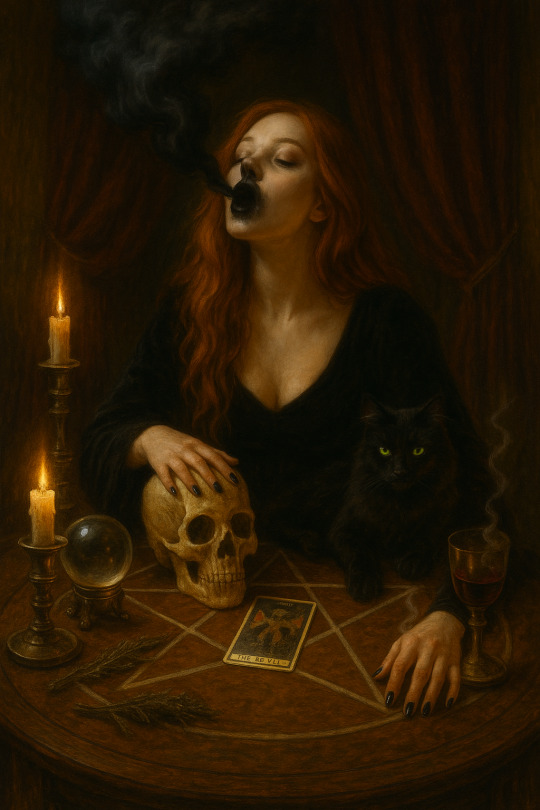
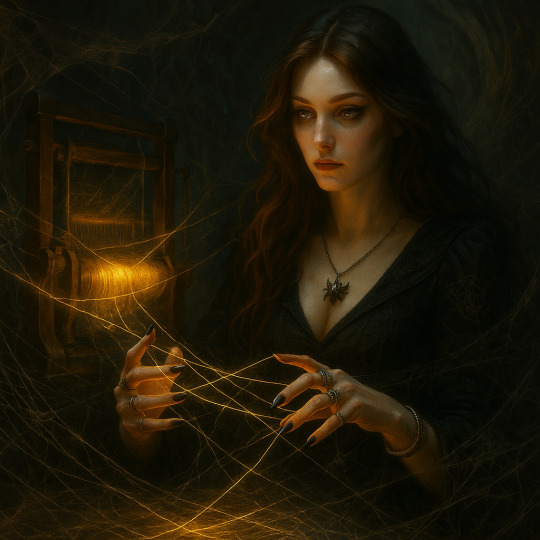
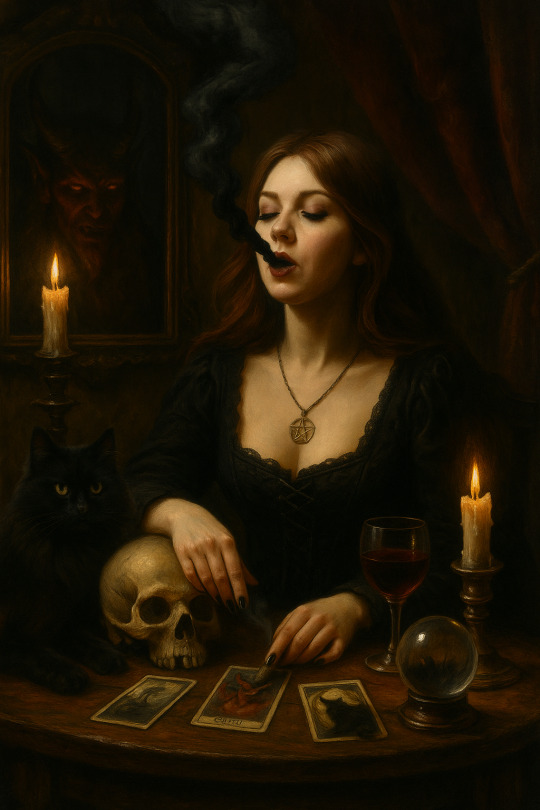
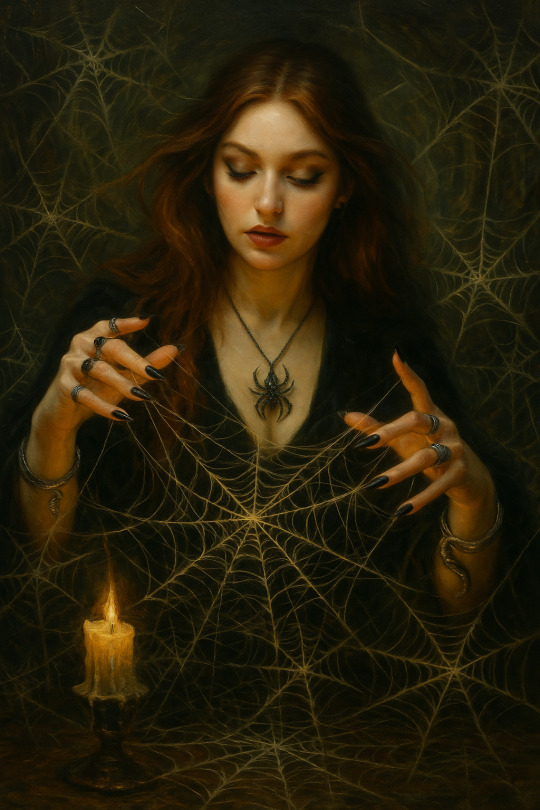
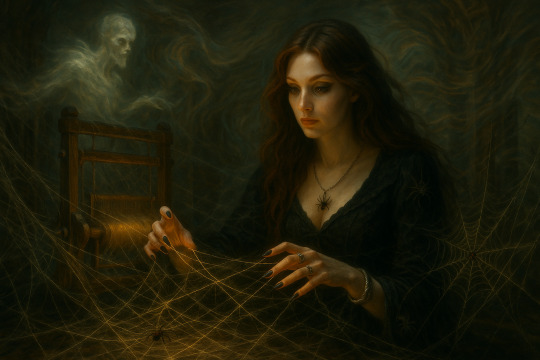

Lilith; The Threadweaver...
(art rendered with likeness to myself)
#ai#ai art#ai artwork#ai generated#metaphysical#magic#magick#magical art#magical#witch#witchcraft#pagan#Lilith#self portrait#Grimoire#Grimoire of Shadows#oc#oc art#oc artwork#ai artist#mystical#original character
10 notes
·
View notes
Text



An important part of your descent and practice into the unknown is doing plenty of research on the Gods, Goddesses, Deity's and Saint's you wish to connect with, without the research your practice will be pointless, knowing as much as possible about your chosen Devotional journey will help you understand how they work and what changes they can bring to your life 🌛🌚🌜. Grimoires are a tool that those who practice devotions use to compile what they have learned and shows the progress they are making in the process of their devotional journey 🙏🖤
#witch community#witch aesthetic#witchcore#witchy vibes#witchcraft#hekate#lilith#santa muerte#grimoires
13 notes
·
View notes
Text
evil monster in my head that says keep making arthur taller and josie shorter
#arthurs so tall already in my head... wizard man what do you need all that for!#more neck to crane lookin at grimoires. and kissing wifes#longer legs 4 evading helene#higher up shoulders for lilith to sit on though that seems like an unsteady venture he is a bit feeble
23 notes
·
View notes
Text

baphomet, mr "i refuse to get involved in your psycho drama that i caused"
#my art#oc#tw bug#?#its kinda gross#lilith stole his grimoire#“where are his collarbone crops in the animatic” im a retconner i retcon whoreish design traits
104 notes
·
View notes
Text




Oc doodles so I remember how to draw them
#Dante#dante grimoire#roseanne louis#lilith#asmodeus#astaroth#demon#demon oc#demonology#art#my art#artwork#digital art#oc#my oc#original character#artists on tumblr
61 notes
·
View notes
Text










knox should be doing homework but instead buries herself in vampire research which leads her to meet caleb and lilith vatore
#she dragged yuki along to impress her enough to join the avant gardes#she also met lucas lol#sims 4#ts4 gameplay#ts4#simblr#the sims 4#ts4 edit#ts4 screenshots#sims 4 gameplay#caleb vatore#yuki behr#lilith vatore#knox blaire#grimoire save*#*should be doing homework but...
28 notes
·
View notes
Note
hey there, would you mind telling me a bit about Lilith and your practice with her? I’ve been trying to do some research on her modern worship, offerings, and signs, but it can be really difficult to find anything that’s serious when there are so many references to her in pop culture :/
Okay so Lilith is extremely, and I mean extremely complicated.
Contrary to popular belief, “Lucifer” isn’t actually a name, but a title. The name Lucifer means “light bringer” in reference to Venus as she appears in the morning, but any “light bringer” can be considered a Lucifer. Prometheus for example, the man who stole fire from the Gods to give light to humanity, is a Lucifer. And so, there are actually many different entities that have taken the role of a Lucifer throughout history and in various different retellings. Eosphorus is the name of the deity that was revered by the Greeks as Venus, but Lucifer is a title that many different figures have taken on depending on the context.
Why do I bring up Lucifer? Because he and Lilith are very similar in that regard. Our earliest mentions of Lilith throughout history paint her not as an individual but as a species of night demon that frequently takes the form of an owl, she was known to bring crib death and miscarriage.
In the myth, Inanna and the Huluppu tree, a huluppu tree (a type of willow) is planted by the banks of the Euphrates River. The tree is tended and nurtured by the goddess Inanna, who plans to use its wood to craft a throne and a bed for herself. However, as the tree grows, it becomes infested with three troublesome creatures:
A serpent that makes its home at the roots of the tree. (What troublesome serpents have been portrayed in another mythology having to do with magical trees? HMM!)
The Anzu bird (sometimes described as a mythical lion-headed eagle) that builds its nest in the branches.
The Lilitu (a female demon or spirit) that makes her lair in the trunk.
Inanna, distressed by these creatures occupying her tree, calls for help from her brother, the sun god Utu (or Shamash). When Utu does not assist her, she turns to the hero Gilgamesh. Gilgamesh comes to her aid and, with his great strength, drives away the serpent, the Anzu bird, and the Lilitu. He uproots the huluppu tree and uses its wood to craft a throne and a bed for Inanna, fulfilling her original intention. Consider that it is a human, not the God of the sun, who helps Inanna with this problem. Interesting.
The inclusion of these three very specific creatures occupying this important tree tended to by the Goddess of love, to her dismay, are very important. Especially when he consider how Inanna’s visual depictions have been syncretized with Lilith. The idea of a serpent (perhaps a Lucifer) , an Anzu bird (described quite similarly to some depictions of abrahamic angels, specifically those like the cherubim) and a Lilith being “driven away” from this mythical tree are notable, especially because these are all symbols associated with Inanna herself.
Inanna, one of the most complex deities in Mesopotamian mythology, embodies aspects of fertility, love, war, and the underworld. Inanna's association with snakes can be seen in her connection to the underworld and her transformative journeys. In her descent into the underworld, Inanna removes one magical garment as she continues into the deathly realm. Just as the snake sheds its skin, Inanna sheds her power and identity as she descends, only to be reborn and restored.
Inanna is frequently depicted with wings, highlighting her divine nature and authority. The Anzu bird in the Huluppu Tree myth, while initially a source of trouble, also connects to the theme of overcoming chaos, which aligns with Inanna's role as a powerful deity who brings order.
Lilith, often depicted as a demoness, represents untamed feminine power, independence, and sometimes chaos. In later Jewish mythology, she is considered a night demon, but her roots trace back to earlier Mesopotamian beliefs. Her inclusion in Jewish mythology is summed up in the verse Isaiah 34:14: "Wildcats shall meet with hyenas, goat-demons shall call to each other; there too Lilith shall repose, and find a place to rest." (Hm… I wonder WHERE she will find a place to rest? Perhaps in a… magical tree?)
In Jewish mysticism, the feminine side of the tree of life is what creates the potential for evil. Even though it is the lightest, brightest, goodest form of feminine energy, for some reason, every time, disobedience pops up no matter what we do. It is an aspect of the feminine itself.
In the Huluppu Tree myth, Lilith (or a Lilitu) makes her home in the tree that Inanna nurtures. This connection reflects Inanna's association with both nurturing and taming wild, untamed aspects of the feminine. Lilith's presence in the tree also highlights the tension between order and chaos, which Inanna must navigate and control.
So what does this all mean?
Each creature in the tree draw direct parallels to the Goddess of Love herself. These can be interpreted as perversions of her divine nature, that she herself cannot be-rid of on her own. Inanna the Goddess of WAR couldn’t get an owl, a big bird, and a snake out of a tree??? Why? Likewise, why did the divinities refuse to help her? Why did she have to seek out a human specifically, to get those unwelcome guests out of her tree? And if it is so that Inanna just doesn’t really like owls and snakes, why is she represented with them (and generally just hanging out with them) so often?
Lilith, the serpent, and the Anzu bird reflect aspects of the divine mother that she herself cannot even tame. Lilith as the night owl also reflects an aspect of knowledge and wisdom, as owls can see in the dark and hunt strategically. Even though she is portrayed as an enemy of Inanna, Inanna never once can or even tries to harm her. Inanna being the Goddess of fertility, and Lilith being the demon that causes miscarriage, show that they are natural opposites, yet still derived from the same divine source, and never combative towards each other.
Similarly, Lucifer’s first ever depiction was as his role as Venus, the same astrological planet as what is associated with Inanna. In Christianity, Lucifer played the role of the serpent who convinced Eve, another archetype of divine femininity, to eat the forbidden fruit of knowledge. Interestingly enough, Lilith is never actually portrayed eating the fruit. Does she posses a divine knowledge that is inherent to her qualities as a night owl, to the point where she didn’t need to eat the fruit to have the wisdom to disobey Adam? Does she possess a knowledge that is inherent to the divine feminine force from which she was created? Is this because she was created from the divine forces of femininity itself and not derived from man, as Eve was? If this is the case, that even though Eve ate the apple, she did not become a Lilith, that stands to imply that there is an inherent quality about being derived from a human man, that repels or deflects that inherent feminine rebellious quality. Instead, being replaced with the the ability to submit.
Knowledge applied with the associations of night and mystery, create a feminine energy that cannot submit, and this is likely Inanna’s fault herself, as she very notably has a big issue with respecting any authority higher than herself, even death herself (as her big sister)
From a symbolic standpoint this tells us a couple things about Venusian energy in general.
1.) Regardless of how hard it tries to behave, it is inherently chaotic
2.) It has many faces, some of which do not jive with eachother, but even so, they continue to coexist, even if not in the same places
3.) It is a creator and a destroyer.
4.) It has a very rough time with the concept of submission.
Okay YAP fest, what’s the point?
Lilith is a great example of how the dark feminine exists within the light feminine as an inevitability. Lilith is not so much associated with war, the strategic enactment of violence., but rather the inherent unpredictability of femininity. Women both create life and snuff it, women can decide to procreate or to have an abortion. Lamashtu and Lilith respectively were invoked for abortive purposes.
And of course, Lilith’s adoption by feminist spaces as a self actualized protector of individuality and feminine rage also invoke heavy associations with Inanna as the Goddess of war. So in my interpretation, Lilith is that part of Inanna that went a little unchecked for a little too long. That combined with the themes of Lucifer’s liberation, paint a very interesting narrative about how femininity as a divine force shows up in obscure ways, perhaps even negative ways, whilst still being just as divine and inherent. To recognize Lilith as the antithesis of all of these things, is to see her as the unwavering aspect of femininity that cannot be tamed, even by femininity herself. The snake, the reborn, will always cause chaos at the root of the feminine energy. The Anzu bird, the angels, are susceptible to that same corruption. And the Lilith herself will always find a home within that feminine energy, unless of course, she is snuffed by the will of a man who doesn’t respect her. Still, she does not die, just searches for another place to rest.
Wow this was really long. SO. Lilith is the entity that embodies our biggest fears about femininity and the inherent knowledge that women posses. Women know how to create life, and women have the ultimate authority in ending it. To honour Lilith as a Goddess rather than a troublesome demon, is to recognize that even the parts of femininity that femininity herself can’t control are divine in nature. The knowledge that she possesses makes women incapable of submission. And the Gods themselves are aware of this, and do not interfere with her, because she is a Goddess herself carrying out an important function, even if it doesn’t adhere to what they might like. Basically, rebellion is an inevitability to any feminine creature that possesses knowledge. It is unavoidable.
It’s incredibly difficult to find anything about the worship of Lilith because for a long time she wasn’t given her flowers as a divinity. Even Inanna herself tried to get her to fuck off. You can honour her quite similarly to the way Artemis and Athena were worshipped, alongside Inanna or Aphrodite of course. As the dark, mysterious, yet inexplicably wise mother of demons, she is the creative force behind destruction. She’s the aspect that exists in all of these Goddesses, that most of us would rather not think about. She is a woman who cannot be held in captivity, if you tell her to procreate, she will cause miscarriage. If you tell her to obey, she will become even more rebellious. The more you repress her, the stronger she becomes. No matter how oppressed women become, no matter how subservient, so long as they have any connection to the divine feminine, they will have a Lilith inside of them.
Lilith’s representation of a succubus expands upon her associations as a woman who does what women do, (men thought women were sex objects for a long time) but not for the sake of cooperation, but for her own means. Lilith is very much a woman, capable of doing what all women and feminine goddesses can do. She simply chooses not to, similarly to how Artemis simply chooses not to procreate. The element of choice, (hello again, Lucifer) always being an option to women is, from a patriarchal standpoint, really scary for men.
So how do you worship her? Worshipping Lilith, like Lucifer, is technically paradoxical. Lucifer wants us to worship ourselves. If he accepts worship it’s because you’re using him as a metaphor for yourself. Lucifer believes in no man submitting to no God, so he won’t take on the role of the usual “authority”. Lilith is quite similar, to worship her is to worship the wise and rebellious spirit that exists in the feminine- yourself. Self honouring acts honour Lilith, just as they honour Lucifer. It’s important to remember that Lilith isn’t just rebellion for the sake of arguing, she isn’t a contrarian. She is self actualization that just happens to not go with the status quo. She does what she wants, if that pisses you off: cope. She’s not inherently against men or procreation, or even women who are submissive. She is the constant exception. The random variable that always pops up whenever we deal with feminine deities. So for me, I honour her as an extension. of every existing goddess. Within Inanna, there is a Lilith, as there is within Aphrodite, Hera, Artemis, Athena, etc etc.
Wow this was long as fuck but I hope it provided a little bit of insight as to why Lilith is so fucking confusing. Regardless of which contexts you feel are the most true, Lilith, like all deities will continue to evolve with time. Just as the narrative around Medusa has gradually changed into her being a victim instead of a monster, Lilith has shifted from being a demon that just kills babies to the ultimate personification of feminine independence. All of these interpretations are correct in the right context, you just have to figure out which context best applies to you.
OKAY if you actually read this far here’s a flower 🌹
#lilith#lilith deity#witchcraft#magick#paganism#pagan#occultism#witch community#witch aesthetic#witchblr#demonology#grimoire#lucifer#inanna#luciferian#goetic demons#goetia#mythology#syncretism
199 notes
·
View notes
Text
a a a
a h
t w h c k
T u
h ₑ F
#wtf#hippie#cottagecore#witchcore#mother earth#witchcraft#witchy#dark cottagecore#dark grunge#forestcore#green witch#satanism#baphomet#beezlebub#lilith#grunge#grimoire#dark indie#darkness#dark fairycore#goth aesthetic#indie#memes
7 notes
·
View notes
Text

I speak in the tongue of forgotten gods.
Saturn carved my silence into scripture,
and made me a cathedral of consequence.
For I do not speak,
I invoke.
I blame Saturn. It’s always Saturn,
braiding time into my spine
so I may walk as prophecy,
not woman.
I was not shaped to be soft.
I was sculpted to remember,
to hold the ache of eras
and transmute every fracture into law.
Decode me,
and you won’t just redirect a memory,
you’ll resurrect something older than time.
But only if you’re worthy.
And let’s be honest…
most collapse at the threshold,
mistaking mystery for menace.
#rebellion#saturn#saturnian#divine#divine feminine#esoteric#lilith#gods#astrology#dark feminine energy#prophet#occult#poetry#spellwork#mystic#mysticism#mystery#portal#digital diary#shadow#words#grimoire
9 notes
·
View notes
Text

♚♛ Witches Academia ♚♛

4 notes
·
View notes
Text

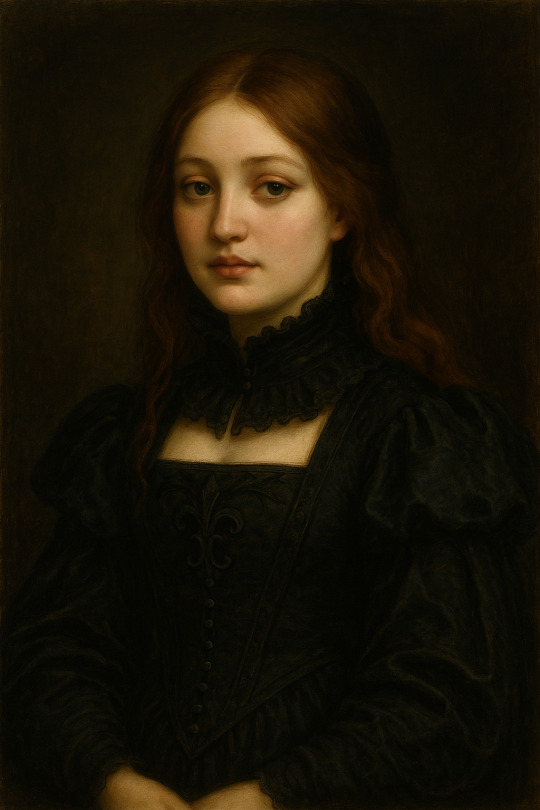
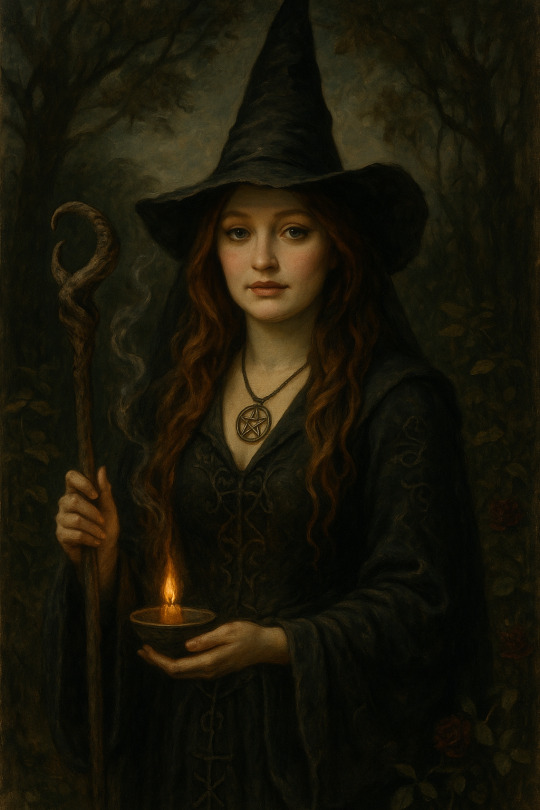
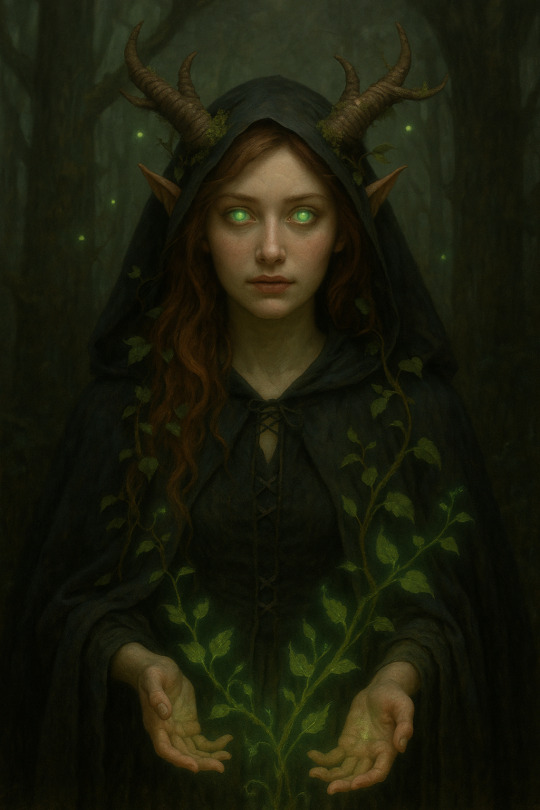


You may call me, Lilith...
(original character rendered with likeness to myself)
#original character#oc#oc art#oc artwork#oc ai art#ai#ai art#ai artwork#ai generated#metaphysical#magic#mystical#demon#goddess#witch#pagan#occult#satanic#mythical creatures#mythical#myth#mythology#grimoire#grimoire of shadows#book of shadow#owned by me#demoness#lilith#self portrait#SublimeNymphetamine
4 notes
·
View notes